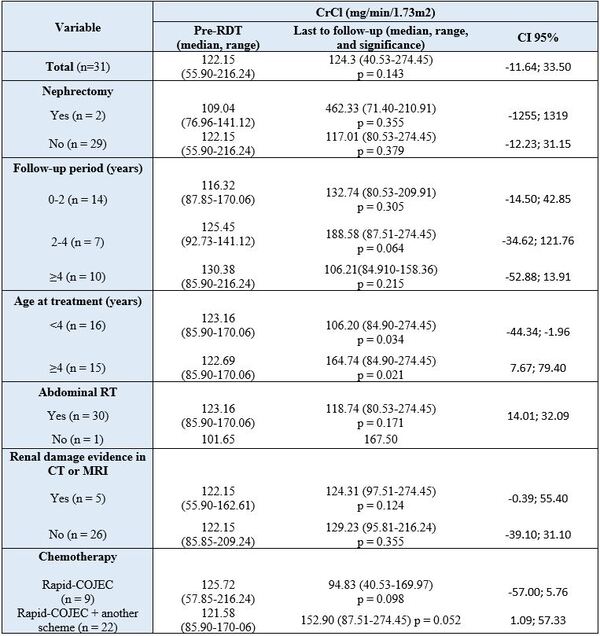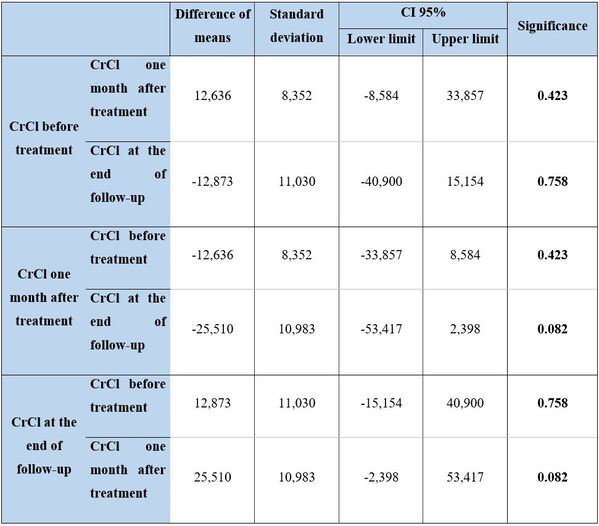Renal toxicity in paediatric patients with high-risk neuroblastoma treated with radiotherapy
Elias Gomis Selles,
Spain
PO-1439
Abstract
Renal toxicity in paediatric patients with high-risk neuroblastoma treated with radiotherapy
Authors: Elias Gomis Selles1, Ana Maria Burgueño Caballero1, Oscar Muñoz Muñoz1, Blas David Delgado Leon1, Patricia Cabrera Roldan1
1Virgen del Rocio University Hospital, Radiation Oncology, Seville, Spain
Show Affiliations
Hide Affiliations
Purpose or Objective
The endpoint of this research is to evaluate
renal toxicity in paediatric patients with high-risk neuroblastoma who have
received radiotherapy (RT) as part of their multimodal treatment.
Material and Methods
Renal function was analyzed through creatinine
clearance (CrCl) calculated according to Shull's formula in pediatric patients
diagnosed with high-risk neuroblastoma. These received radiotherapy as part of
the definitive treatment between January 2004 and May 2020 in a single institution.
A comparison of blood urea nitrogen (BUN),
creatinine and creatinine clearance (CrCl, according to Shull's formula) was
evaluated between the last laboratory analysis before treatment, one month
after treatment (median = 31 days) and the last one in follow-up. Only routine
tests were selected.
All CT (computed tomography) and MRI (magnetic
resonance imaging) images performed after treatment were reviewed for the
presence of renal atrophy.
We performed subgroup analyzes based on age in
treatment, presence of nephrectomy, follow-up period, abdominal radiotherapy,
evidence of kidney damage in imaging tests and using of more than one
chemotherapy regimen.
Data were analyzed using a paired Student's
t-test, Wilcoxon test and a post-hoc intergroup analysis through an ANOVA test
for repeated measures adjusted by Bonferroni. We considered a significant
result if p value < 0.05. The Saphiro-Wilk test was used to study normality.
Results
31 children with median age of 38 month at
diagnosis were treated with RT as a radical aim. All patients received 21 Gy in
14 sessions with IMRT (intensity-modulated radiotherapy).
In the analysis by subgroups, we only found a
significant decrease (p value = 0.034) in CrCl in patients below four years old
treated with RT (n = 16), however, the values remained within the
non-pathological physiological range (Table 1).
A post-hoc intergroup analysis compared the
means of the three laboratory determinations (before treatment, one month after
treatment and at the end of follow-up) without finding significant differences (Table 2).
The main side effects in the imaging tests were
renal atrophy (32.3%), increased vertebral uptake (16.1%) and scoliosis (3.2%).
Moreover, two patients (6.4%) developed
arterial hypertension that required treatment. No patient developed significant
renal dysfunction.
Table 1

Table 2

Conclusion
Our cohort presented an excellent renal outcome
after radiotherapy. A significant decrease in creatinine clearance has been
observed in patients under four years of age when treated with radiotherapy.
Nevertheless, the renal function always remained within the non-pathological
physiological range, therefore this finding is not clinically relevant.
Pathological values that suggest renal failure
have not been obtained in any determination. No patient developed chronic renal
dysfunction.